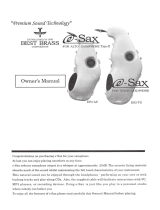Page is loading ...

Assembly
and Care
of the
Saxophone
GRAND RAPIDS
2855 Lake Eastbrook Blvd, 49512
(616) 975-1122
HOLLAND
675 East Lakewood, 49424
(616) 396-6583
MUSKEGON
1664 East Sternberg, 49444
(231) 865-7000
GENERAL CARE
When the saxophone is not being played, it
should be kept in the case to prevent dust
from collecting in the mechanism or prevent
possible damage from accidental dropping
or bumping. AVOID PUTTING THE CASE IN
PLACES WHERE IT IS SUBJECT TO EXTREME
TEMPERATURES. Do not put extra items such as
books, clothing, etc. in your case.
If at any time you feel the instrument needs
repair, take it to Meyer Music for this to be
done properly. Doing it yourself can damage
the instrument.
KEEP YOUR INSTRUMENT IN GOOD PLAYING
CONDITION BY USING A...
ALTO SAXOPHONE
CARE KIT
CONTENTS:
Instruction Manual
Mouthpiece Brush
Mouthpiece Saver
Duster Brush
Tube Cork Grease
Reedguard II
Body Swab
Neck Cleaner
Step VII – Loosen the neck receiver screws and
remove neckpipe carefully with a twisting motion.
Using a saxophone neckpipe brush, clean the
inside of the neck.
Step VII
Step VIII – Remove water
from the bow of the
instrument by tipping the
saxophone bell down-
ward allowing the water
to run out the bell. (Tip
saxophone so that the
water does not wet the
pads of the bell keys.)
Step VIII
Step IX – Wipe out the bell with a soft cloth as far as
you can reach. Using a saxophone chamois swab,
clean the inside of the body.
Step IX

ASSEMBLY AND CARE OF THE SAXOPHONE
Congratulations on your choice of instruments.
You are playing one of the most expressive of all
wind instruments. To assist you in the proper
preventative care of the instrument so you may
obtain the best possible results from it - this
booklet has been prepared for you.
Your saxophone assembly includes the three
main parts of your instrument. These are (from
top to bottom): the mouthpiece, neckpipe and
the complete body (body, bell and bow).
GREASE THE NECK CORK
Before assembling the saxophone, the neck
cork must be given
a thin coat of cork
grease prior to placing
the mouthpiece in
position. Apply cork
grease onto the cork
each time the instru-
ment is assembled for
the first week and
then only as needed
thereafter.
NECK STRAP
Place the neck strap
over your neck. With
right hand grasp the
bell of the instrument
to remove the saxo-
phone from the case.
Hook the neck strap to
the strap ring and adjust
the strap so that the
weight of the saxophone
is on the strap.
Step I – Remove the
neck plug and loosen
the neck receiver screw.
Grasp neckpipe in the
right hand and place
neck into the neck
receiver with a twisting
motion. Be careful not to
jam the neck key loop
onto the octave key
pickup on the body.
Step II – Line neck up
with the strap ring
Step III – Placing the reed on the mouthpiece is
very important. First place the ligature on the
mouthpiece with your right hand. After soaking the
reed in your mouth, slide it under the ligature on the
flat position (lay) of the mouthpiece.
Step I
Step II
Step IV – Position the
reed so that it is on the
middle of the facing
(lay). Generally, the tip
of the reed should
be even with the tip
of the mouthpiece.
The position of the reed
on the mouthpiece has
a great effect on the
way the instrument
plays. Make certain the
reed is straight and even
on the mouthpiece
facing. Be sure not to
twist the ligature screws
too tightly.
Step V – Place the
mouthpiece in your right
hand. With a gentle
twisting motion, push the
mouthpiece onto the
neck cork to the desired
position.
Step VI – Now that your
saxophone is completely
assembled, adjust the
neck strap up or down,
bringing the mouthpiece
directly in line with your
mouth.
Step IV
Step V
Step VI
When you are finished playing, the instrument
should be put away as carefully as it was assembled.
Remove the reed and ligature and store the reed
in your Reedguard. Take the mouthpiece off the
neck with a twisting motion.
/



